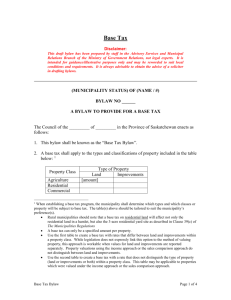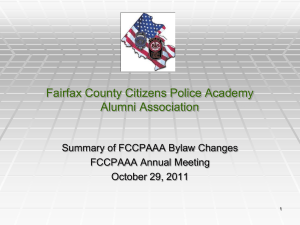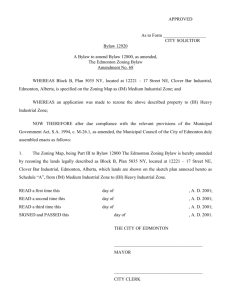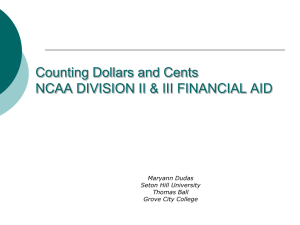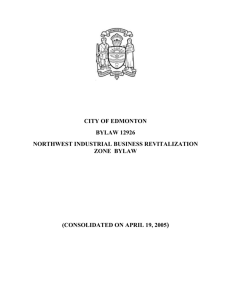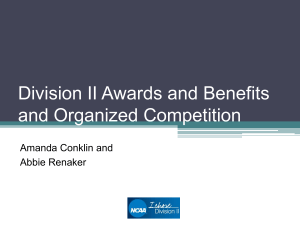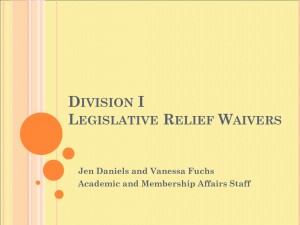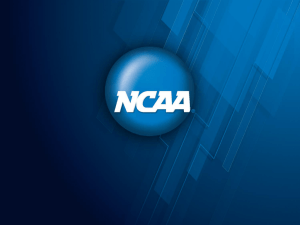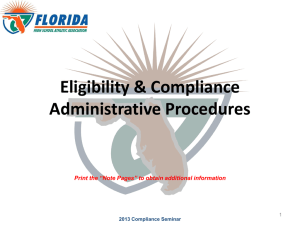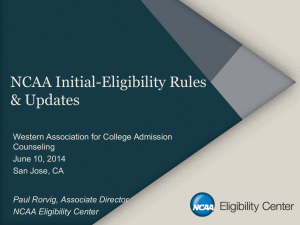Division II Progress Toward Degree
advertisement
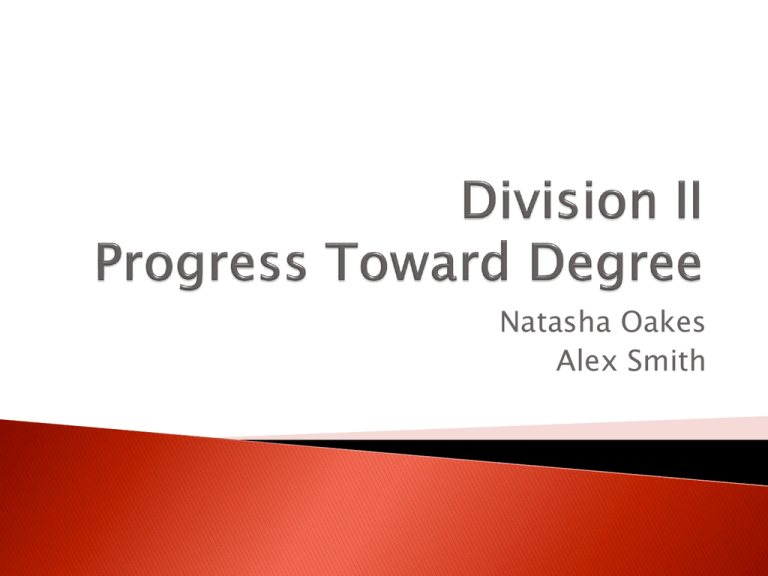
Natasha Oakes Alex Smith Session outcomes. Learning objectives. Case studies. Resources. Leave with a better understanding of: ◦ Good academic standing; ◦ Progress-toward-degree requirements; and ◦ Progress-toward-degree legislated waivers and exceptions. Distinguish between NCAA eligibility requirements and good academic standing on campus. Identify credit-hour triggers. Differentiate between applicable credit-hour and GPA requirements. Demonstrate ability to appropriately apply the averaging and actual methods, including recertification. Accurately calculate GPA for continuing and transfer SAs. Discuss applicable progress-toward-degree exceptions and legislated waivers. Identify helpful resources available to the membership. To be eligible for intercollegiate athletics competition: ◦ Maintain progress toward a baccalaureate or equivalent degree. ◦ In general, the application progress-toward-degree requirements is interpreted at each member institution by the academic authorities who determine the meaning of such for all students (subject to conference or association legislation. Institution is determining if the legislation is being met. Defined by each member institution. Could be more stringent than association legislation. To be interpreted by the academic officials who determine the meaning for all students. Bylaw 14.02.6 Six credit-hour requirement. ◦ Complete six-semester or six-quarter hours. ◦ Preceding regular academic term while enrolled full time. Must be transferable if coming from two-year or fouryear institution. Bylaw 14.4.3.1.1 Exceptions to the six-hour rule. ◦ Final academic year of degree program. Bylaw 14.4.3.1.6.1 ◦ Graduate student exception. Bylaw 14.4.3.4-(d) ◦ Cooperative education and study abroad. Bylaw 14.4.3.3.11 24-hour requirement. Applies to the following SAs. ◦ Midyear transfer; ◦ Following completion of first academic year in residence; ◦ Used one season of competition. How are the 24 hours calculated? Two methods. ◦ Actual. ◦ Averaging. Actual method. ◦ Complete 24-semester or 36-quarter hours. Since the beginning of the fall term; or Since the beginning of the institution’s preceding two semesters or three quarters. Averaging method. ◦ Complete an average of 12-semester or 12-quarter hours before each fall term. ◦ During each full-time term at the certifying institution. Use of credits from a part-time term. Bylaw 14.4.3.1.3 75/25 rule. ◦ Must earn at least 75% of the minimum number of semester or quarter hours during the regular academic year. ◦ Must earn no more than 25% of the minimum number of semester or quarter hours during the summer. Institution Credits Attempted Credits Earned Participation Fall 2009 DII 15 15 Competed Spring 2010 DII 12 12 Competed Fall 2010 DII 12 6 Competed Spring 2011 DII 15 6 Competed Summer 2011 DII 6 6 Term Institution Credits Attempted Credits Earned Participation Fall 2009 DII 15 15 Competed Spring 2010 DII 12 12 Competed Fall 2010 DII 12 6 Competed Spring 2011 DII 15 6 Competed Summer 2011 DII 6 6 Fall 2011 DII 15 15 Term Practiced Is there a way for Josie to “get well” for spring 2012? ◦ Averaging? Josie has a total of 60 hours for five full-time terms. 60/5 = average of 12 per full-time term. STOP!!!...averaging method can only be used going into the fall semester. What about the actual method? Institution Credits Attempted Credits Earned Participation Spring 2011 DII 15 6 Competed Summer 2011 DII 6 6 Fall 2011 DII 15 15 Term Total number of hours? Does she meet 75/25? Practiced Hours earned or accepted for degree credit. ◦ During first two years of enrollment; ◦ Beginning of fifth semester/seventh quarter; ◦ Change of degree program. Advanced placement/credit by examination. Bylaw 14.4.3.3.3 ◦ NCAA Proposal No. 2012-4 – Credit hours earned prior to initial full-time enrollment. Correspondence and distance learning courses. Bylaw 14.4.3.3.4 Can an SA take a full-time load of correspondence courses? ◦ Yes, must be considered full time and degree seeking by institution. May be used if they meet the following: ◦ Must be considered prerequisites; ◦ Must be considered toward full-time status; ◦ Noncredit courses may not exceed the maximum institutional limit; ◦ Shall not take more than 12-semester or 18-quarter hours; and ◦ Must be taken in first academic year of collegiate enrollment. Applicable interpretation. ◦ Remedial, tutorial and noncredit courses taken the summer following initial enrollment may be used to meet progress-toward-degree requirements. Official Interpretation: September 1, 2010 Incomplete grades. ◦ Must follow institution’s regulations; ◦ Counted only once after acceptable grade has been achieved; ◦ Counted in term according to institutional policy; ◦ If no policy, can be counted in either the term it was taken or when grade was achieved. Repeated courses. ◦ Course repeated due to unsatisfactory grade may be used once after satisfactorily completed. ◦ Credit for a course that may be taken several times is limited by institutional regulations. ◦ May not exceed maximum institutional limits. Don passed Microeconomics with a D grade during the 2011 spring term, which is accepted in his major and is used to certify his eligibility for the 2011-12 academic year. Don decides he would like to repeat the course during the 2011 fall term. This time he earns a B grade. It is institutional policy to replace his D grade with the B grade he earned. Does the replacing of the grade earned in spring 2011 effect Don’s eligibility? Is the institution able to use the repeated course to certify Don’s eligibility for spring 2012? GPA requirements. 24-semester/36-quarter hours = 1.800. 48-semester/72-quarter hours – 1.900. 72-semester/108-quarter hours = 2.000. GPA only needs to be checked prior to the fall term. If eligible at that point, the SA is eligible for the academic year. Does not matter if the SA reaches the next hour requirement during the year. Taylor is going into her junior year at Elizabeth University (EU). At the start of the 2011-12 academic year, she had 58semester hours with a 2.000 GPA. EU requires that all students maintain a 2.000 GPA at the start of each semester. Taylor’s GPA going into spring 2012 is 1.900. Is Taylor meeting GPA requirements set forth in Bylaw 14.4.3.2? 24-semester/36-quarter hours = 1.800. 48-semester/72-quarter hours = 1.900. 72-semester/108-quarter hours = 2.000. What about EU’s policy regarding GPA? Missed term. ◦ May be used one time; ◦ Used with averaging method; ◦ Cannot have engaged in outside competition; ◦ Must have been eligible for enrollment; ◦ Must be meeting progress-toward-degree requirements. Cannot use this exception in first year in residence at certifying institution to be eligible in second year. Bylaw 14.4.3.4-(a) Cooperative Education, Work Experience and Study-Abroad Programs. ◦ Not be required to complete six-hour requirement during any term or terms of enrollment in a cooperative educational or work experience program. Includes co-op, internship, practicum, studentteaching or an institutionally approved study-abroad program. Bylaw 14.4.3.3.11 Midyear enrollee. ◦ Entering second semester or second or third quarter. ◦ Used with actual method. ◦ Prorated at 12 hours. Bylaw 14.4.3.4-(b) Nathaniel is a midyear transfer from Hawthorne College who satisfied the onetime-transfer requirements to be immediately eligible at your school for spring 2012. How many hours does Nathaniel have to earn to be eligible for the 2012-13 academic year? Bylaw 14.4.3.1-(b) ◦ 24-hour requirement. ◦ Applies to midyear transfer SAs. What exception can be used (if any)? ◦ Midyear enrollee. How does it apply? ◦ Prorate 12 hours for fall 2011. ◦ Must earn 12 hours prior to fall 2012, with at least nine being earned in spring 2012. Nonrecruited, nonparticipant. ◦ Must have been in residence for one year; ◦ Not recruited per Bylaw 13.02.10.1; ◦ No athletically related financial aid received; ◦ Never practiced or competed. Limited preseason tryout. Bylaw 14.4.3.4-(c) Two-year nonparticipation or minimal participation. ◦ Two years of no countable athletically related activity since last participation; ◦ 14 consecutive calendar day period; ◦ Organized noncollegiate amateur competition while not enrolled; ◦ Must be after initial full-time enrollment in college. Bylaw 14.4.3.4-(e) Ineligible for competition. ◦ Ability to “get well.” What about practice during the year of residency? Administered by conference. ◦ Medical absence. Bylaw 14.4.3.5-(a) ◦ International competition. Bylaw 14.4.3.5-(b) Administered by NCAA national office. ◦ Progress-toward-degree waivers. Bylaw 14.4.3.8 ◦ Less than full-time enrollment waivers. Bylaw 14.1.8.1.8 Online waiver portal to file all AMA waivers. Launched February 2011. ALL waivers must be filed via online portal, including documentation. Waivers will not be accepted via the portal until all required documentation and signatures are submitted. What is the mitigation? How does it tie to the deficiency? Complete waiver request. Appropriate documentation. NCAA Division II Manual. ◦ Bylaw 14.4.3. ◦ Bylaw 14.1.8. Legislative Services Database for the Internet. Academic and membership affairs. Review of academic requirements. ◦ Areas for additional progress-toward-degree discussions and potential concept development. Identified during the February 2102 meeting of the NCAA Division II Academic Requirements Task Force. ◦ Timeline for review. ◦ Opportunity for feedback. Initial progress-toward-degree discussions reiterated the Division II core value of SA progression toward and achievement of a baccalaureate degree. Identified specific progress-toward-degree areas that may enhance graduation based on initial data review for additional research and future meeting discussions. ◦ Currently no consensus regarding the viability of any of these areas. Areas identified include: ◦ Requiring nine credit hours per term of full-time attendance; ◦ Requiring a term-by-term GPA minimum; ◦ Review of the averaging method as an alternative to the actual method for credit-hour certification; ◦ Review of percentage-of-degree requirement models; and ◦ Review of a four-year graduation model. February 2011 • Initial review of current initial-eligibility requirements and data collected through the Academic Performance Census. July 2011 • Initial review of NCAA Division I two-year transfer proposals. September 2011 • Continued discussion regarding initial-eligibility requirements and initial discussions on progresstoward-degree requirements and Division II two-year transfer requirements. November 2011 • Faculty Athletics Representatives Association (FARA) – introduced to the NCAA Division II Academic Requirements Committee’s review of the academic requirements. January 2012 (NCAA Convention) • NCAA Division II Presidents Council/ Management Council Joint Meeting—introduced to the Academic Requirements Committee’s review of academic requirements. February 2012 • First meeting with Academic Requirements Task Force. • Continued discussion regarding initial-eligibility, progress-toward-degree and two-year transfer requirements. • Initial recommendations developed. March 2012 through December 2012 • Continual review and discussions by the Academic Requirements Committee and other governance groups. • Continual review and feedback by the Division II membership, including but not limited to the Athletic Directors Association, Conference Commissioners Association, FARA and coaches associations. January 2013 (NCAA Convention) • Educational session regarding potential legislative changes to academic requirements. • NCAA Division II Chancellors and Presidents Summit to review and discuss potential legislative changes to academic requirements. February and July 2013 • Committee meeting and summer teleconference to finalize legislative proposals – may add additional in-person meeting if necessary. January 2014 (NCAA Convention) • Legislative proposals considered by Division II membership. Feedback and questions regarding the currently identified areas for additional review are welcome and may be sent to diiacademicreview@ncaa.org
